Driver Swing Adjustments
Most of golf, you can play with the same swing. The two areas where your regular golf swing is of little use are:
- a) On the Putting Green
- b) Off the tee (driver only)
The putting green is a little easier to explain. One doesn’t really need to worry about shaky balance (due to a quickened backswing) or generating a good shoulder turn etc. In my experience, a key aspect of making more putts is to develop a sense of the speed with which the putt needs to be hit (most putts that are missed – are missed SHORT).
The driver swing changes are a little harder to explain. After all, the same swing SHOULD, theoretically, work with a driver. Especially, if it works with your 3 wood! A driver is just an inch (or two, at most) longer than a 3 wood. Why should the swing (or setup) change at all for such a minor change?
These are all valid questions. However, as it turns out, there is ONE thing about the driver that is SO unique – that it entails introducing a couple of ‘adjustments’ – both in your setup and your swing.
A driver tee-shot is the ONLY shot in golf – where you hit UP on the ball. Hitting a driver with a descending (or even a flat) blow is a self-defeating exercise. A driver was designed to connect with the ball on the UPSWING.
While it may seem innocuous, this little detail accounts for SEVERAL changes – in both the SETUP and the SWING with a driver.
SETUP Changes
The alignment of your forearms is crucial for your driver setup. This is because:
- Forearms Assist with the driver weight – Both the forearms need to be aligned (if someone on your RIGHT looks at your arms, they should see just ONE blended forearm instead of two – see image below). The RIGHT forearm actually needs to be slightly ahead of the left (see image below). This will enable your right shoulder and forearm to assist in the takeaway – which would, otherwise, be too ‘heavy’ for the left arm by itself. This slight tweak also allows the left forearm to start rotating over the right forearm – as the club moves back.
- Shoulders Pointed Left of Target Line – The right forearm being slightly AHEAD also means your right shoulder is SLIGHTLY ahead of the left. The SHOULDER line (a line passing from your right shoulder to your left) should point SLIGHTLY LEFT of the target line. This is again CONTRARY to all other shots – where your shoulders point PARALLEL to the target line. Carl Lohren, noted golf instructor, publicized this simple setup modification (which, is actually used by a lot of tour players today).
- Head Back – The right ear should feel like it is over the right shoulder. Without the head being held back, there is no way (humanly possible) to hit UP on a ball (a ball positioned opposite your left armpit).
| Right forearm SLIGHTLY ahead | Shoulder Line – LEFT of target line | Head stays back – as you hit UP on the ball. | ||
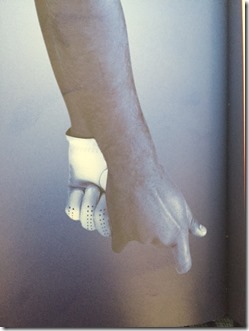 |
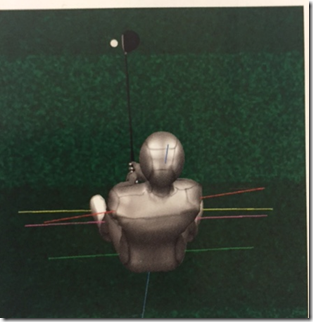 |
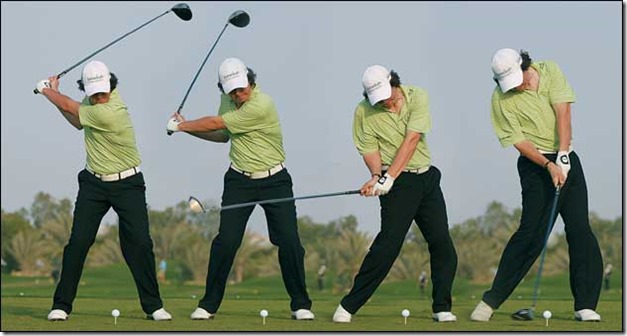 |
While I learned these tweaks from a variety of coaches (both in the US and in India), there are several professional golfers and teachers (see Carl Lohren, noted golf instructor) who promote these modifications listed above.
With these small SETUP tweaks, you are ready to make a full driver swing – and hit the ball on the UPSWING.
SWING Changes (Driver Swing THOUGHTS)
Hitting a ball on the UPSWING takes a little getting used to. Like we discussed earlier, there is no other shot in golf where such a clubhead trajectory (club travelling upwards) is needed to make solid contact with the ball. In fact, quite the opposite – all iron play requires a somewhat descending blow (you can even get away with a flat / slightly descending blow with fairway woods).
Some swing thoughts while hitting a driver are:
- Your head must, must stay back. This was listed in the SETUP tweaks above – however, it could equally well be listed as a driver swing thought. Watch Rory in the image above to get an idea of the importance of the head staying back. The head stays back – there is no other way humanly possibly to hit UP on a ball (that is positioned opposite your left armpit).
- BOTH your forearms need to contribute equally at impact. The driver is one of those clubs that is too heavy to be controlled by just one dominant arm. Most iron shots (and even the fairway woods) – you actually provide more power with your left side than your right. The right side (arm) engages only towards the end – and helps go through impact. With the driver, the right forearm is required to work in SYNC with the left – and they both contribute equally to the impact. They should go THROUGH the ball like butter through a knife.
- Forget about HITTING at the ball – think more of SWINGING THROUGH the ball – with your forearms.
What about the wrist break?
In your regular golf swing, your wrists need to break in a way such that your left wrist is flat (or parallel to the clubface) – at the very top. This, though easily accomplished with most clubs, is again a challenge specific to the driver (due to its exceptional weight). If you try to think of your wrist at the top of the swing, chances are you will have trouble getting it flat.
An easier thought is to think of your FOREARM (left Forearm) at the top of the swing. The forearm needs to be FLAT – and parallel to the clubface. With the forearms doing the rotating, the driver head feels somewhat lighter – and one can get to the desired position at the top of the swing. Of course, a flat FOREARM results in a FLAT wrist – but I have found it easier to think in terms of forearms when it comes to the driver.
I am not able to get a good shoulder turn
Getting a good coil is crucial to generating power. Unless you get your backswing sequence (turn the triangle back) right, this is normally very difficult to do. For most amateurs, the whole idea of keeping a fixed triangle turning at a steady pace (one-piece takeaway) – requires a lot of practice. I struggled with that myself – and kept a lookout for a ‘shortcut’.
I found just such a shortcut (with a coach in India) – in the right foot back drill. Once you get used to that drill, you will not need to worry about a one-piece takeaway – or struggle with obtaining a good coil. These things happen automatically – with your right foot pulled back slightly.
However, calling it a ‘drill’ is a bit misleading. This is something that you can take to the course – and use on the course. You would be in the company of Ben Hogan and Jason Dufner ( among other golf greats) – all of whom leverage this little known secret.
| Hogan – Right foot pulled back slightly |
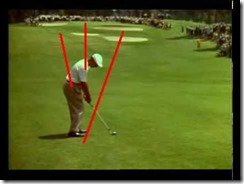 |
Summary
Hitting UP (on a golf ball) is a very, very different type of shot – from all other shots in golf. In order to accommodate this ‘driver specific’ requirement, one needs to alter one’s SETUP a little.
One needs to pay particular attention to the head – with the right ear staying atop the right shoulder throughout the swing (like Rory illustrates above).
The actual swing will entail the forearms BREAKING (similar to the WRISTS breaking) on the backswing – and rotating powerfully THROUGH the ball – on the downswing. This slightly modified swing will take a little practice, no doubt.
Keep in mind that the swing doesn’t violate any of the two fundamentals of golf – keeping your balance – and getting a good shoulder turn.
In fact, these slight modifications assist you in keeping your balance (head back) – and getting a good turn (using the forearms to carry the weight of the clubhead and pulling your right foot back).
I promise you – once you get the hang of RELEASING BOTH your forearms through the ball, you will never consider hitting a driver any other way. It feels like butter going through knife – and you actually do not FEEL the impact – it is that smooth.
The right forearm contributing at impact will give you distance (and straightness) that are ‘tour worthy’.
Questions? Comments?
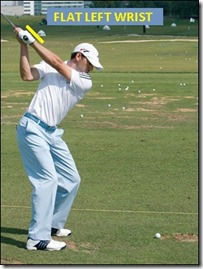
I dont understand why you keep saying that the driver is the heaviest club, when it’s quite the opposite. My driver is the lightest club and has the lightest swingweight in my bag.
Weighing less than 300 grams, with swingweight C9.
Good point. It just ‘feels’ heavier – since the clubhead is at the end of a longer shaft. I believe that is what coaches mean when they talk about it being harder to swing the driver..I will edit that in the post. Thanks for the feedback.
Your advice about pointing thé grip towards thé ball in thé downswing is thé best i ever received. It has changed m’y play with irons and Woods. But i have difficulty with thé driver, and your above article explains why.
Then what downswing should i adopt ?
Thank you so much for your excellent articles
Best regards, Albert Ohana